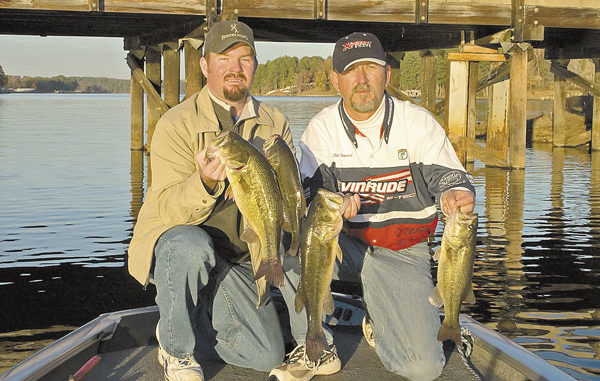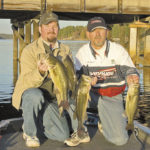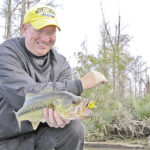
This time of year, largemouths group up in the tight spots between deep and shallow water.
Dawn began to define what we had dubbed the “slough hole.” It was the first morning of rifle season in Area 1, and from 15 feet up an oak tree that was dropping acorns on my head, I remembered how this came to be the fourth deer stand I put up. To my south, the Bogue Chitto River flowed west to east. To my north was a pine plantation bordered by old hardwood fencerows that surrounded two new food plots. Early camera scouting revealed deer would be leaving the pines during the morning to return to the river swamp.
My stand was strategically placed over the only place they could travel to get to the swamp. The sprawling slough forced every deer that wanted to move from the pines to the swamp to cross a narrow road over two culverts. Like an interstate construction zone, this road pinched all deer movement into one narrow lane.
I couldn’t get my slough stand out of my mind later that evening as I started skinning my deer. Bottleneck, funnel, pinch point — whatever you want to call it, the road crossing the slough took some of the guesswork out of deer hunting because they were forced to cross it.
Unbelievably, I took a call from an old bass fishing buddy of mine later that evening who was thinking about the exact same thing at the exact same time.
“Chris, you know about how deer hunters set up stands on funnels that force deer to move through certain areas?” he asked, and then listened to my story. “Well, have you ever thought about applying the same concept to bass fishing? Louisiana’s lakes are full of pinch points that force bass to move through narrow areas to get to where they’re going.”
Sid Havard and I fished team bass tournaments together when I lived in West Monroe, and as we spoke, he reminded me of a spot we used to fish on Lake Claiborne. We would catch a lot of bass in the back of Benson Bay in a protected pocket behind a bridge so narrow I used to worry about gouging my gel coat as we passed by the pilings.
“Those bass aren’t back there all year long,” said Havard. “We used to catch them back there during the spring and again in the fall. Like all those deer that cross your slough stand, every one of those bass in the back of that pocket had to pass under that bridge at least twice — once on their way in and again on their way out.”
Apparently, Havard started poking around that little bridge after I moved away. By his own admission, he wasn’t fishing it because it was a pinch point; he was fishing it because it was a bridge. What he learned was that if he hit it just right when bass were on the move, he could target every bass that would wind up in a 10-acre pocket under a 10-foot bridge.
Havard isn’t the only angler who has figured out that pinch points are great places to target constricted bass. Covington tournament angler Jason Pittman has seen the same concept at work in the rivers and marshes surrounding his North Shore home.
“A lot of times we think of them as migration routes in the marsh or on rivers,” Pittman explained. “From a marsh perspective, you look at little bayou that connects a canal with a pond or lake, and you’re looking at a pinch point. And take the West Pearl River, for instance. Bass can’t spawn in the river, so they’re forced to move in to spawn through little cuts and chutes — all pinch points.”
Since pinch points are constricted pieces of water through which bass move, the key to fishing them is being there when the bass are moving. Generally speaking, bass move shallow to spawn during the spring and then move back out. That’s two movements through pinch points. Then they move shallow again to feed during the fall before moving back out for winter. That’s two more.
Other factors that move bass through pinch points are bait movement and current. In a lake or river, current could be created by the wind, rain runoff washing through a culvert or normal water flow patterns. In the marsh, tide pushes bass around just as much as it does speckled trout and redfish.
“Tide more than anything in the marsh,” Pittman said. “If the tide is coming up, bass are going up with the water to find fresh food or new areas to feed. Bass know there’s food up there in places they can’t get when the tide is low, so they move up through all kinds of little pinch points to get to it.”
Because tidal movement is a daily part of a marsh bass’s life, anglers can take advantage of hitting them in the pinch points a lot more frequently than anglers in big lakes or rivers can. Rather than hitting them every day in a lake, it may be more like every three months.
“But you can fish pinch points in lakes more often if you fish after rains because every lake has culverts,” Havard said. “But instead of pinching off bass movement, it pinches off bait movement, and bass sit there and gorge on bait and crawfish washing out.”
Havard recalled fishing a giant culvert on the Ouachita River a few years ago where the water was running out of a backwater lake instead of into it. The fellow fishing with him mashed the button on his reel and let a topwater bait wash through the culvert to where they could see bass busting on the other side.
“He smoked them,” Havard said. “Every bass he caught was on the other side, and he had to reel them through that culvert.
“But that’s not the only case where you might be able to hit pinch points more frequently. Take the Red River for instance. Everybody knows that the water moves back and forth through the cuts in the rocks based on what’s going on in the locks. Those cuts are pinch points.”
Fishing pinch points doesn’t take a lot of time or effort because of their constricted nature. Not only might 200 acres of wide open lake neck down to 300 yards, but 15 feet of water may come up to 5.
“I hit them with square-billed crankbaits,” Havard said. “They don’t run too deep, but they run deep enough. I like the Lucky Craft crankbaits, but any of the square bills will work well in this situation. I know a lot of people also throw Rat-L-Traps in pinch points. Both lures allow you to effectively cover the area quickly to see if fish are present.”
Pittman concurred that pinch points are best fished with quickly moving baits designed to trigger reaction strikes. Because tidally influenced bass don’t stick around in a pinch point very long, Pittman throws Rat-L-Traps, jerkbaits and spinnerbaits to pick off bass as they are passing through.
“Fishing pinch points in the marsh is more about timing than anything else,” Pittman said. “Bass move through them to get somewhere else. They generally don’t live in pinch points, so you’ve got to be there when the fish are there.
“How many times have we killed them in this ditch going out to such and such then went back two days later without any bites. That should help you figure out that the fish were just moving through. If you pay attention to the conditions when you caught them, that will help you learn when to fish it again.”
Havard passed along another tip before we ended our call. He loves finding pinch points that have some kind of obstruction in them. The example he used was a log washed up into a corner of a small canal connecting the main lake with a small pocket.
“Obstructions serve as big current breaks,” he said. “Say you’ve got a 25-foot wide pinch point, and it’s got a log or stump in the corner. Bass are going to tuck in behind that piece of cover and wait on something to eat.
“You can do the same thing at a pinch point with a bridge over it. All those pilings serve as current breaks, and bass will get behind them to get out of the current. When something comes by, they dart out, grab an easy meal and retreat right back into or beside the cover.”
As you travel around your favorite lake, river or marsh this year, don’t just pass through the pinch points to get to the other side. Drop your trolling motor and stick around a while because you just might find out why so many expert deer hunters are also expert bass anglers.
Neither deer nor bass get big by being stupid, and neither can get from one spot to another without traveling through pinch points. Shooting fish in a barrel? Nope, but it’s pretty close.




